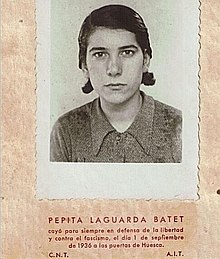Pepita Laguarda Batet (1919–1936), was a Catalan anarchist militiawoman who fought on the Aragon front during the Spanish Civil War. She was incorporated into the libertarian ranks without having yet reached adulthood and died in Uesca at the age of seventeen. She was the youngest soldier to die in combat during the war.[1]
Pepita Laguarda Batet | |
|---|---|
 Pepita Laguarda Batet (1936) | |
| Born | 1919 Barcelona, Catalunya, Spain |
| Died | 2 September 1936 (aged 16–17) Granyén, Uesca, Aragón, Spain |
| Allegiance | |
| Service | |
| Years of service | 1936 |
| Unit | Ascaso Column |
| Battles / wars | Spanish Civil War: |
Biography
editBorn in Barcelona, Pepita Laguarda lived in the L'Hospitalet de Llobregat district of Santa Eulàlia with her parents and three brothers. Her mother, Matilde Batet, was a working-class member of the Confederación Nacional del Trabajo (CNT) and introduced her to anarchist ideas.[2]
When the Spanish Civil War broke out in 1936, she signed up as a nurse at a hospital in Sarrià.[3] She soon learned that volunteers were being recruited to fight in the combat zones. She decided to enlist, against the advice of her father,[1] who accompanied her to the recruitment centre at the Mikhail Bakunin barracks in Pedralbes to try and change her mind, but to no avail.[3]
When she informed her boyfriend Juan López Carvajal, also a CNT activist, of her decision, he decided to follow her into the war. The young couple took up arms as part of the Ascaso Column and left to fight on the Aragon Front.[2] On 30 August, the attack on Uesca began. On 1 September 1936, having been fighting for hours, she was seriously wounded in the shoulder under fire at 5am. She rescued by the Red Cross, which transferred her to Vicién hospital for first aid.[4] Her condition meant she had to be taken to Granyén hospital, where she died at 9.30am, in the arms of her companion.[1][5]
Juan informed Solidaridad Obrera of her passing,[6] deeply moved by the death of his first love.[7] He wrote about his relationship with Pepita in his autobiography, published in France in 1995.[8]
See also
editReferences
edit- ^ a b c Población, Félix (11 March 2020). "Pepita Laguarda (1919-1936), the youngest female militian [sic] killed in action". El Salto. Translated by Sharkey, Paul. Retrieved 1 June 2023 – via Kate Sharpley Library.
- ^ a b Barreira, David (4 May 2019). "Con Pepita, miliciana de 17 años, ya van más de 4.000: la enciclopedia de las mujeres en la Guerra Civil". El Español (in Spanish). Retrieved 1 June 2023.
- ^ a b Cadenas Cañón, Isabel (12 April 2021). "Pepita la heroína". Público (in Spanish). Retrieved 1 June 2023.
- ^ Pinós, Daniel (28 December 2020). "Pepita Laguarda Batet (1919-1936)". Memoria Libertaria (in Spanish). General Confederation of Labor. Retrieved 1 June 2023.
- ^ Gabriel Cardona (1986). La batalla de Madrid. Historia 16. p. 114. ISBN 978-84-85229-96-3.
- ^ Bellpuig, Jaime (13 September 1936). "Nuestras Heroinas: La compañera Pepita Laguarda Batet ha caído hericomente a los pies de la ciudad de Huesca" (PDF). Solidaridad Obrera (in Spanish). No. 1378. p. 7 – via Cedall.
- ^ Forné, Agustí (5 April 2021). "Pepita Laguarda, una de les 1.195 històries de dones soldat del llibre "Les combatents"". Corporació Catalana de Mitjans Audiovisuals (in Catalan). Retrieved 1 June 2023.
- ^ Lopez Carvajal, Juan (2013). Mémoires de ma vie (in French). Lille: The Book Edition. ISBN 9782746645301.
Further reading
edit- Andrés Granel, Helena (2007). "Queremos escribir de nuevo la palabra mujer. Mujeres libres y la construcción de una nueva identidad femenina". In Millán, María Ángeles; Peña Ardid, Carmen (eds.). Mujeres y los espacios fronterizos. Zaragoza: Zaragoza University Press. pp. 165–188. ISBN 9788477338871.